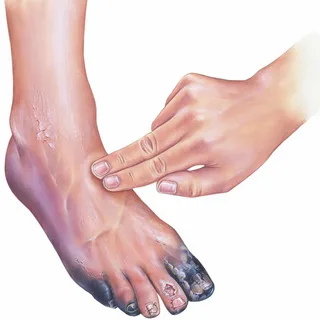Diabetic Foot Gangrene Treatment: Causes, Symptoms And Treatment

Does your foot feel numb or tingly? If so, you may have diabetic foot gangrene. Diabetic foot gangrene is a type of gangrene that can develop in people with diabetes. Gangrene is a condition that results when tissue fails to heal after an injury. In diabetic foot gangrene, dead skin and blood vessels accumulate over the affected area, which leads to tissue damage and pain. If left untreated, diabetic foot gangrene can spread and cause amputation. To prevent diabetic foot gangrene from happening, keep your blood sugar levels under control and visit your doctor if you experience any unusual symptoms. Here are the types of diabetic foot gangrene treatment, their causes and symptoms, and the treatment options available.
Causes And Symptoms Of Diabetic Foot Gangrene
If you’re a diabetic and experience the following symptoms, it’s time to go to the doctor: pain, redness, swelling, and ulceration. If left untreated, diabetic foot gangrene can lead to amputation. The accumulation of toxins in the feet’ blood and tissues causes this condition. To prevent it, it’s important to maintain good foot hygiene and get regular check-ups. If you experience diabetic foot gangrene, be sure to seek medical help as soon as possible, as it can improve your overall health and outcome.
What Is Diabetic Foot Gangrene?
Diabetic foot gangrene is a serious foot infection commonly caused by poor circulation and oxygenation. It most commonly affects the toes but also other parts of the foot. Symptoms of diabetic foot gangrene include a red, swollen, itchy foot and pain when pressure is applied to the affected area. If left untreated, diabetic foot gangrene can lead to amputation of the affected foot. Treatment usually involves antibiotics and/or surgery to remove necrotic tissue from affected foot areas. If you are experiencing symptoms of diabetic foot gangrene, it is important to seek medical attention as soon as possible.
Treatment Of Diabetic Foot Gangrene
There’s no doubt that diabetic foot gangrene is a dreaded disease. It can cause skin cancer and is typically treated with antibiotics and surgery to remove the tumour or cancerous cells. If left untreated, diabetic foot gangrene can lead to amputation. Diabetes is a disease that can cause foot gangrene, which is a form of skin cancer. The symptoms of diabetic foot gangrene include redness and swelling in the affected area. If you experience any of these symptoms, you must see a doctor as soon as possible.
Symptoms
If you’re a diabetic and you experience foot gangrene, don’t wait to get treatment. This is a complication that can occur in people with diabetes and is particularly common in those who have poor blood circulation. Treatment usually involves antibiotics and other medications to improve blood flow to the area. If left untreated, foot gangrene can lead to amputation of the affected limb. Symptoms of foot gangrene include severe pain, redness, and swelling around the foot or lower leg. If you experience any of these symptoms, don’t wait to get help. Contact your doctor, and be sure to mention that you have diabetes.
Conclusion
Gangrene is a serious complication that can arise from diabetic foot ulceration. This condition is caused by the accumulation of blood and pus in the tissue of the foot, which can lead to tissue damage and gangrene. Although it is rare, gangrene surgery is a serious medical condition that requires prompt treatment. Here are the different types of diabetic foot gangrene, the causes and symptoms of the disease, as well as the different treatments available. If you or someone you know is suffering from diabetic foot gangrene, make sure to seek medical help as soon as possible!




